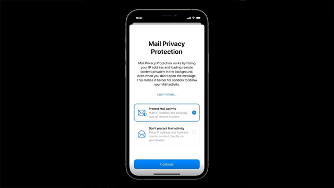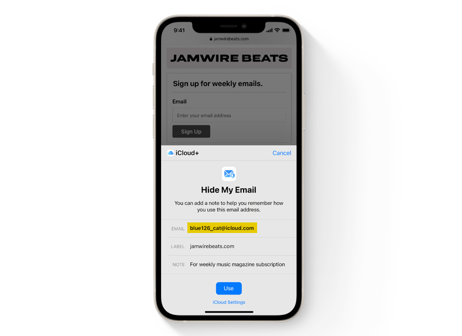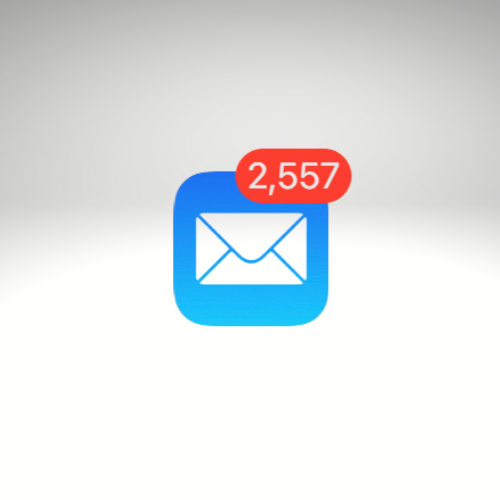How "The Fold" Has Evolved in Email Marketing
Marketing buzzwords come and go, but some stick around longer than others. One such term is ‘the fold’ in email marketing—that invisible line where...

Just when marketers were getting used to the new reality of Apple’s privacy protections and their impact on Facebook and Instagram advertising, here comes iOS 15.
With iOS 15, Apple will focus on email privacy, giving users more control over what trackable information they share through email to protect them from risk.
As a user, this sounds great. As a marketer, prepare for drastic changes to your email marketing, especially how you will track success.
To understand how iOS 15 will change email marketing, let’s review how marketing emails are typically tracked.
A pixel is embedded in the email code when you use an email marketing tool to send newsletters or transactional emails to your mailing list. Typically, this comes in the form of a 1 pixel-by-1 pixel transparent image—usually a .GIF or .PNG file—into the header, body, or footer of an email. And while this pixel isn’t noticeable to the eye, it allows a tremendous amount of valuable data to be sent back to the marketer.
The pixel delivers information that may include the recipient’s IP address, location, whether they opened the email and, if they did, the day and time that it was opened, and more.
This level of detail helps marketers measure the impact and success of their email list, the subject line used, the creative, and the email content to ensure it’s all performing as best as possible.
The release of iOS 15, which may come as early as next month (September 21), changes everything. At that time, Apple Mail app users will benefit from a free feature called Mail Privacy Protection, which will keep email pixels from tracking all of the data we’re used to receiving.

And if that’s not enough to ruin your day: there’s more!
While Mail Privacy Protection will come free within the Apple Mail app, users will have the option to purchase a subscription to iCloud+.
This subscription comes with additional privacy features, including a Private Relay (think VPN), which prevents sites from tracking Safari users.
More significantly, iCloud+ subscribers will have access to a feature called Hide My Email. Not leaving much to the imagination, this feature will allow users to provide a “fake” email address when filling out a form. This email address will serve as a go-between to the user’s actual email address.

The new Hide My Email addresses will all be @icloud.com addresses with random or jumbled prefixes, so if you see an increase in @icloud.com subscribers you can assume those are hidden emails.
This not only means that marketers won’t have their users’ actual email addresses to create custom audiences, but with Hide My Email, a user can simply delete the “fake” email address rather than unsubscribe. Time will tell what this will look like in your analytics but anticipate higher bounce rates that really should count as unsubscribes.
Apple Mail comes standard on all Apple devices and is the leading email client overall. That said, your list may be different, so take a look at any device data your email tool is providing to you now before it goes away. You may find some comfort in knowing that these features won’t be available to everyone. At least not yet.

Plus, features like Hide My Email will require a subscription, so not everyone who uses Apple Mail will pay for the additional privacy features.
But those are just hopes, and hopes aren’t plans. So what can you do to prepare for what’s to come?
While the changes from iOS 15 won’t impact everyone on your list, they will impact enough people to cause your numbers to skew from their historical trends. As more email becomes untraceable, you need to understand your new normal and ensure that these changes are communicated to any stakeholders who may not understand the impact that iOS 15 will have on your email campaigns and analytics.
Ensure you’re tracking and creating pre- and post-iOS 15 benchmarks for open rates, clickthrough rates, site traffic from email, unsubscribe rates, subject lines, time of day, day of the week, and “from” lines.
Also, a user’s ability to delete their temporary email address through Hide My Email will likely impact deliverability. Keep a close eye on your bounce rate and ensure your email marketing tool removes hard bounces from your mailing list.
Quality content and click-worthy subject lines are not a new priority for email marketing, but as users gain more control over their information, it’s important to consistently remind them of the value you offer in your emails and why you deserve a place in their inbox.
If you aren’t doing so already, begin A/B testing subject line variations and content for your core automated emails to ensure everything is performing well before you start to lose visibility into some of these metrics.
If you’re genuinely focused on building the right audience for your business and consistently delivering valuable content to them, the open and clickthrough rates will take care of themselves whether you’re able to track them or not.
Review and remove (or at least segment) inactive subscribers from your list. Once iOS 15 is introduced, you won’t be able to use open rate data to determine whether they’re engaged or not.
Additionally, you may want to reconsider any behavioral segments you currently have. For example, you may want to develop an engaged segment based on clicks, site activity, or purchases rather than basing engagement on open rates.
Those still coping with the impact Apple’s privacy protection has had on their Facebook and Instagram marketing understand the effect this may have on email marketing. Knowing that 94% of Apple users opted out of Facebook’s tracking proves there is a demand for these types of privacy features – and a willingness to use them.
While, like Facebook, email marketing platforms will be working to quickly develop tools and methods to provide more data to marketers despite these protections, it is best to begin to prepare yourself and your campaigns now.
Sign up for our monthly newsletter to receive updates.

Marketing buzzwords come and go, but some stick around longer than others. One such term is ‘the fold’ in email marketing—that invisible line where...

Email marketing is a challenge, especially in the face of the ongoing competition for your customers' attention from social media, messaging apps,...

It's that time of year again! Black Friday and Cyber Monday are right around the corner. Businesses are trying to figure out how get the most out of...